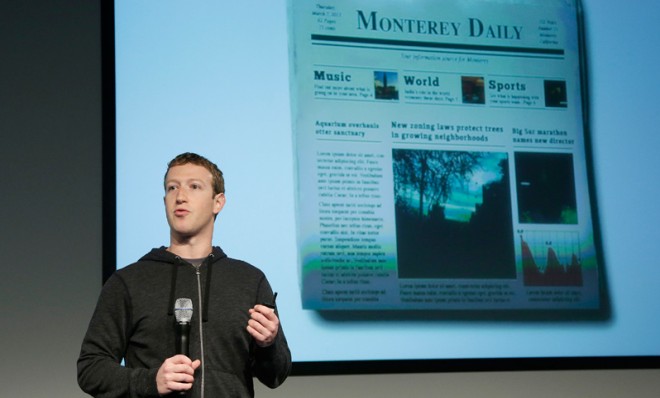Mark Zuckerberg's attempt to counteract 'Facebook fatigue'
Will Facebook's 1 billion active users like the first major redesign since 2006?

Facebook's first major redesign since 2006 isn't "just cosmetic," says Will Oremus at Slate. CEO Mark Zuckerberg clearly wanted a sleeker and less-cluttered look, but his chief aim is to make the world's most popular social networking site into something more like a "personalized newspaper" or "a well-curated magazine" for its 1 billion active users. By toggling between different, content-specific versions of their news feed, users can opt to display only their friends' updates, or only photos, or only news from pages and public figures they follow. The redesigned news feed "acknowledges what's become true since 2006," says Matt Buchanan at The New Yorker. "We're swimming in streams." The revamped news feed provides some relief from sensory overload by filtering out noise and being "both visually rich and spare, with bigger, wider photos, videos, and maps set against vast expanses of pleasantly neutral space." But it does absolutely nothing to address "a more essential problem: Facebook fatigue."
And a pesky problem that is, says Quentin Fottrell at MarketWatch. The people who essentially invented social networking now face the bitter truth that "social networkers are notoriously fickle." A survey released last month found that 20 percent of American adults have stopped visiting Facebook altogether, while more than 60 percent of users have taken a break of several weeks or more. The social giant isn't "in danger of going out of style any time soon," but it needs to keep pace with its users' changing habits — especially if it wants to bring back former fans and attract crucial advertising dollars.
Facebook is smart to be revamping in a way that literally looks at the big picture, says Rebecca Greenfield at The Atlantic Wire. Facebook users gravitate to photos more than to anything else on the site. Once Facebook rolls out its new look in coming weeks, each photo post will appear much larger, and sponsored posts with photos will get the same treatment. "It's a smart trick, making the ads look like photo posts in the new feed." If the new design gets users to flock back to Facebook, the site could start charging higher rates by providing more prominent and better-targeted ads. But "if users don't, in fact, engage with those huge ads, the potential downside to larger visuals" could be an even harsher backlash to obnoxious ads.
The Week
Escape your echo chamber. Get the facts behind the news, plus analysis from multiple perspectives.

Sign up for The Week's Free Newsletters
From our morning news briefing to a weekly Good News Newsletter, get the best of The Week delivered directly to your inbox.
From our morning news briefing to a weekly Good News Newsletter, get the best of The Week delivered directly to your inbox.
Let's not be naïve, says Seth Fiegerman at Mashable. This is all about ads. The overhauled news feed is a big step toward integrating lucrative video ads into Facebook's revenue stream. Advertisers hope that the site's new emphasis on visual content will "give them more room to create richer and larger ad units, including videos." They're especially interested in interactive ads that allow users to click, play, expand, and share videos and brands without leaving their pages. But the looming question is whether video ads in the news feed will alienate users. Even Facebook knows there are limits to what they will tolerate. "What we want to figure out is the intersection of what users will love and what marketers could love," one executive said. Bigger ads may mean big bucks for the firm, but it's not clear whether this Facebook makeover is something users will "like."
A free daily email with the biggest news stories of the day – and the best features from TheWeek.com
Sergio Hernandez is business editor of The Week's print edition. He has previously worked for The Daily, ProPublica, the Village Voice, and Gawker.
-
 Political cartoons for January 4
Political cartoons for January 4Cartoons Sunday's political cartoons include a resolution to learn a new language, and new names in Hades and on battleships
-
 The ultimate films of 2025 by genre
The ultimate films of 2025 by genreThe Week Recommends From comedies to thrillers, documentaries to animations, 2025 featured some unforgettable film moments
-
 Political cartoons for January 3
Political cartoons for January 3Cartoons Saturday's political cartoons include citizen journalists, self-reflective AI, and Donald Trump's transparency